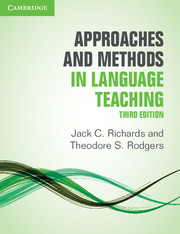Book contents
- Frontmatter
- Contents
- Acknowledgments
- Introduction to the third edition
- I Major trends in twentieth-century language teaching
- II Current approaches and methods
- III Alternative twentieth-century approaches and methods
- IV The teaching and learning environment
- Appendix: Comparison of approaches and methods
- Author index
- Subject index
7 - Whole Language
Published online by Cambridge University Press: 08 April 2022
- Frontmatter
- Contents
- Acknowledgments
- Introduction to the third edition
- I Major trends in twentieth-century language teaching
- II Current approaches and methods
- III Alternative twentieth-century approaches and methods
- IV The teaching and learning environment
- Appendix: Comparison of approaches and methods
- Author index
- Subject index
Summary
Introduction
While directions in language teaching are generally initiated from within the field of language teaching itself, sometimes trends and movements in general education impact language teaching practices as well. Such is the case with the Whole Language movement – the focus of this chapter – as well as with the notion of multiple intelligences which we turn to in Chapter 12. While the term Whole Language as used in second language teach-ing came to encompass the four skills, the term was created in the 1980s by a group of US educators concerned with the teaching of what is referred to as language arts, that is, the teaching of reading and writing for first language learners. The development of reading and writing in the first language (often termed the teaching of literacy) is a very active educational enterprise worldwide, and, like the field of second language teaching, has led to a number of different and at times competing approaches and methodologies. Traditionally, a widespread approach to the teaching of both reading and writing focused on a “decoding” approach to language. By this is meant a focus on teaching the separate components of language such as grammar, vocabulary, and word recognition, and in par-ticular the teaching of phonics. Phonics is based on the theory that reading involves iden-tifying letters and turning them into sounds. Other reading theories approach reading through a focus on the individual skills or micro-skills that are believed to be involved in fluent reading. The Whole Language movement was developed as a reaction to teach-ing methods such as these. It emerged when “top-down” reading theories were being promoted (the use readers make of context, background knowledge, and inferencing to enable them to avoid word-by-word or “bottom-up” reading strategies) by influential reading specialists such as Kenneth Goodman, Marie Clay, and Frank Smith. The Whole Language movement was strongly opposed to approaches to teaching reading and writ-ing that focused on isolated and discrete features of language and argued that language should be taught as a “whole”: “If language isn't kept whole, it isn't language anymore” (Rigg 1991: 522).
- Type
- Chapter
- Information
- Approaches and Methods in Language Teaching , pp. 139 - 149Publisher: Cambridge University PressPrint publication year: 2014

